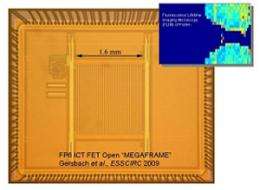World's fastest camera takes a new look at biosensing

A European consortium comprising NPL, ST Microelectronics, the University of Edinburgh, and TU Delft has been involved in the development and application of the Megaframe Imager - an ultrafast camera capable of recording images at the incredible rate of one million frames.
Faster, higher resolution cameras
Since the introduction of solid-state optical sensors, like those found in digital cameras, the main trend has been towards increasing the resolution (i.e. number of pixels) while miniaturising the chip.
However, the other factor is the number of frames the chip is capable of recording in a given time. Until recently, fast cameras (i.e. those capturing more than the 24 frames per second required for 'normal' video) were only used in niche markets in science and entertainment.
Ultrafast cameras
Now that higher-than-video speeds are achievable, a whole new range of previously unthinkable applications have emerged – such as: cellular / sub-cellular imaging; neural imaging; biochemical sensors; DNA / protein microarray scanning; automotive collision studies; and high-sensitivity astronomical observations.
The Megaframe Imager uses an extremely sensitive single photon avalanche diode (SPAD) device, and bespoke on-chip intelligence and has shown for the first time that it could potentially be a powerful technology in biosensing.
Reporting in the Optical Society of America's new journal Biomedical Optics Express the research team have demonstrated detection of viral DNA binding events using fluoresence lifetime imaging at the very low target concentrations relevant in biosensing applications with acquisition times of less than 30 seconds.
DNA microarrays are important tools for biomolecular detection. Widely used for gene expression profiling, disease screening, mutation and forensic analysis, they also hold much promise for the future development of personalised drugs and point of care testing devices.
More information: Read paper in Biomedical Optics Express: Fluorescence lifetime biosensing with DNA microarrays and a CMOS-SPAD imager
Provided by NPL

















